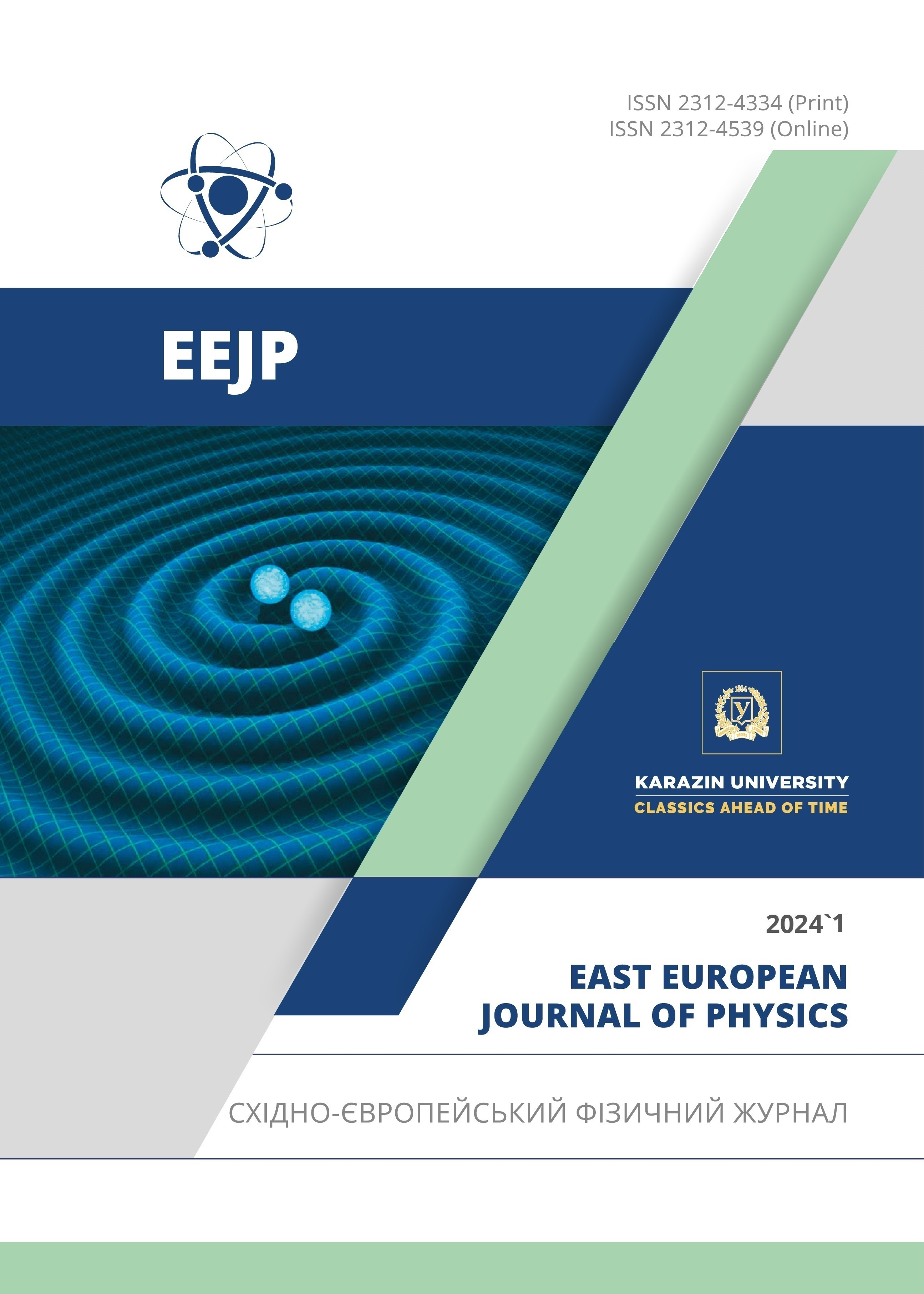Effect of Induced Magnetic Field on MHD Flow Between Two Parallel Porous Plates at Constant Temperature Gradient in Presence of Inclined Magnetic Field
Abstract
The paper studies effect of induced magnetic field on laminar convection flow of a viscous electrically conducting incompressible fluid between two parallel porous plates at constant temperature gradient in presence of a uniform inclined magnetic field. An angle (θ) is formed with the vertical line by applying a magnetic field in that direction and field is strong enough to induce another field along the line of flow. Using the proper similarity transformations, the flow equations are converted into ordinary differential equations, which are then numerically solved by using MATLAB's bvp4c solver. Plotting of the graphs allows one to examine the effects of several critical parameters such as Hartmann number, Darcy number, Magnetic Reynolds number, Prandtl number, and Field inclination on velocity field, induced magnetic field, temperature field at the plates. The acquired results demonstrate that the flow system is effectively influenced by the field inclination, the magnetic parameter, and the plate porosity. The rise in field inclination leads to an increase in magnetic drag force.
Downloads
References
J. Hartmann, “Theory of the laminar flow of an electrically conductive liquid in a homogeneous magnetic field,” Fys. Med. 15, 1-28 (1937).
J.A. Schercliff, A textbook of magnetohydrodynamics, (Pergamon press, London, 1965).
V.M. Soundalgekar, “Free convective effects on Stokes problem for an infinite vertical plate, Proceeding of the Mathematical Society,” BHU, 12, 47 (1977).
A. Raptis, and A.K. Singh, “MHD free convection flow past an accelerated vertical plate,” International Communications in Heat and mass transfer, 10(4), 313-321 (1983). https://doi.org/10.1016/0735-1933(83)90016-7
V.M. Soundalgekar, and Bhatt, “Oscillatory MHD channel flow and heat transfer,” Indian J. Pure Applied Math. 15, 819-828 (1984).
K. Das, and D.C. Sanyal, “Hydromagnetic convecting slip flow through a horizontal channel,” Indian Journal of Theoretical Physics, 42(1), 63-72 (1994).
T. Paul, B. Jha, and A. Singh, “Transient free convective flow in a vertical channel with constant temperature and constant heat flux on walls,” Heat and Mass Transfer, 32(1-2), 61-63 (1996). https://doi.org/10.1007/s002310050092
S. Chakraborty, and A.K. Borkakati, “Unsteady free convection MHD flow between two heated vertical parallel plates in induced magnetic field,” Indian Journal of Theoretical Physics, 47(1), 43-60 (1999).
D. Lensic, D. Ingham, Pop I and C. Storr, “Free convection boundary layer flow above a nearly horizontal surface in a porous medium with Newtonian heating,” Heat and Mass Transfer, 40(9), 665-672 (2004). http://dx.doi.org/10.1007%2Fs00231-003-0435-y
P.R. Sharma, and G. Singh, “Unsteady MHD free convective flow and heat transfer along a vertical porous plate with variable suction and heat generation,” Int. J. Appl. Math. Mech. 4(5), 1-8 (2008).
G. Palani, and U. Srikanth, “MHD flow past a semi infinite vertical plate with mass transfer,” Nonlinear Analysis: Modeling and Control, 14(3), 345-356 (2009). https://doi.org/10.15388/NA.2009.14.3.14500
R.K. Singh, A.K. Singh, N.C. Sacheti, and P. Chandran, “On hydromagnetic free convection in the presence of induced magnetic field,” Heat and Mass Transfer, 46, 523-529 (2010). https://doi.org/10.1007/s00231-010-0594-6
B.K. Jha, and I. Sani, “Computational treatment of MHD of transient natural convection flow in a vertical channel due to symmetric heating in presence of induced magnetic field,” Journal of the Physical Society of Japan, 82, 084401 (2013). https://doi.org/10.1515/ijame-2017-0036
A. Kumer, and A.K. Singh, “Unsteady magnetohydrodynamic free convective flow past a semi-infinite vertical wall by taking into account the induced magnetic field,” Applied Mathematics and Computation, 222, 462-471 (2015). https://doi.org/10.1016/j.amc.2013.07.044
Sarveshanand, and A.K. Singh, “MHD free convection between vertical parallel porous plates in the presence of induced magnetic field,” Springer plus, 4, 333 (2015). https://doi.org/10.1186/s40064-015-1097-1
M.M. Hamza, “Free convection slip flow of an exothermic fluid in a convectively heated vertical channel,” Ain Shams Engineering Journal, 9(4), 1313-1323 (2016). https://doi.org/10.1016/j.asej.2016.08.011
A. Goswami, M. Goswami and K.G. Singha, “Unsteady MHD free convection flow between two heated vertical parallel plates in the presence of a uniform magnetic field,” International Journal of Scientific Research in Mathematical and Statistical Sciences, 7, 86-94 (2020). https://www.isroset.org/pdf_paper_view.php?paper_id=1837&12-IJSRMSS-03181.pdf
B.K. Goud, P.P. Kumer, and B.S. Malga, “Induced magnetic field effect on MHD free convection flow in nonconducting and conducting vertical microchannel,” Heat Transfer, 51, 2201-2218 (2021). https://doi.org/10.1002/htj.22396
B.K. Jha, and B. Aina, “Impact of induced magnetic field on magnetohydrodynamic (MHD) natural convection flow in a vertical annular micro-channel in the presence of radial magnetic field,” Propulsion and power research, 7(2), 171-181 (2018). https://doi.org/10.1016/j.jppr.2018.04.004
J. Mng’ang’a, “Effect of chemical reaction and joule heating on MHD generalized couette flow between two parallel vertical porous plates with induced magnetic field and Newtonian heating/cooling,” 2023, 9134811 (2023). https://doi.org/10.1155/2023/9134811
Copyright (c) 2024 Kankana Rabha, Saleem Jabed Al Khayer, Shyamanta Chakraborty

This work is licensed under a Creative Commons Attribution 4.0 International License.
Authors who publish with this journal agree to the following terms:
- Authors retain copyright and grant the journal right of first publication with the work simultaneously licensed under a Creative Commons Attribution License that allows others to share the work with an acknowledgment of the work's authorship and initial publication in this journal.
- Authors are able to enter into separate, additional contractual arrangements for the non-exclusive distribution of the journal's published version of the work (e.g., post it to an institutional repository or publish it in a book), with an acknowledgment of its initial publication in this journal.
- Authors are permitted and encouraged to post their work online (e.g., in institutional repositories or on their website) prior to and during the submission process, as it can lead to productive exchanges, as well as earlier and greater citation of published work (See The Effect of Open Access).








